

Middlesex University London. Journal of Writing in Creative Practice: Ingenta Connect Table Of Contents. HomePage. The name 'Writing-PAD' is an acronym for Writing Purposefully in Art and Design The Mission We promote 'thinking-through-writing' to further the greater good.
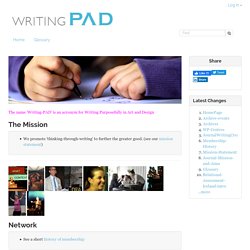
(see our mission statement) Network Events: New Writing-PAD workshops for 2019! Coming soon watch this space. People Consultancy Writing-PAD acts as a consultancy for institutions considering Art and Design provision in English as an International Language (EIL). Contact Julia Lockheart (contact j.lockheart@gold.ac.uk). Journal Our Journal of Writing in Creative Practice Glossary of terms Archive of Events: Here are some of the past events that have happened across the network. Signature pedagogies. TL Signature Pedagogies. Deductive, Inductive and Abductive Reasoning - TIP Sheet - Butte College. TIP SheetDEDUCTIVE, INDUCTIVE, AND ABDUCTIVE REASONING Reasoning is the process of using existing knowledge to draw conclusions, make predictions, or construct explanations.
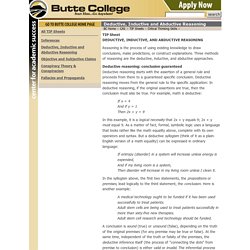
Three methods of reasoning are the deductive, inductive, and abductive approaches. Deductive reasoning: conclusion guaranteedDeductive reasoning starts with the assertion of a general rule and proceeds from there to a guaranteed specific conclusion. Deductive reasoning moves from the general rule to the specific application: In deductive reasoning, if the original assertions are true, then the conclusion must also be true. For example, math is deductive: If x = 4And if y = 1Then 2x + y = 9 In this example, it is a logical necessity that 2x + y equals 9; 2x + y must equal 9. If entropy (disorder) in a system will increase unless energy is expended,And if my living room is a system,Then disorder will increase in my living room unless I clean it.
References1. 2. What is Ideation – and How to Prepare for Ideation Sessions. Ideation is the process where you generate ideas and solutions through sessions such as Sketching, Prototyping, Brainstorming, Brainwriting, Worst Possible Idea, and a wealth of other ideation techniques.
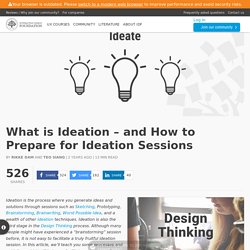
Ideation is also the third stage in the Design Thinking process. Although many people might have experienced a “brainstorming” session before, it is not easy to facilitate a truly fruitful ideation session. In this article, we’ll teach you some processes and guidelines which will help you facilitate and prepare for productive, effective, innovative and fun ideation sessions. Ideation is often the most exciting stage in a Design Thinking project, because during Ideation, the aim is to generate a large quantity of ideas that the team can then filter and cut down into the best, most practical or most innovative ones in order to inspire new and better design solutions and products.
“Ideation is the mode of the design process in which you concentrate on idea generation. Exploring Threshold Concepts: An example of a Threshold Concept in Art History. The Threshold Concept. Threshold Concepts in Practice (2016) Edited by Ray Land, Jan H.

F. Meyer and Michael T Flanagan Educational Futures: Rethinking Theory and Practice, Michael A Peters (Series Editor), volume 68Sense Publishers, Rotterdam/Boston/Taipei, 2016 ISBN: 978-94-6300-510-4 (paperback), ISBN: 978-94-6300-511-1 (hardback), ISBN: 978-94-6300-512-8 (e-book) Threshold Concepts in Practice brings together fifty researchers from sixteen countries and a wide variety of disciplines to analyse their teaching practice, and the learning experiences of their students, through the lens of the Threshold Concepts Framework.
The majority of chapters in this book are developments of talks first presented at the Fifth International Biennial Threshold Concepts Conference: Threshold Concepts in Practice, Durham University, Durham, United Kingdom, 9-11 July, 2014. Meyer and land threshold concepts. Threshold Concepts in Art Education: Negotiating the ambiguity in pre-service teacher identity formation. Art History Teaching Resources. The Artist as Educator: Examining Relationships between Art Practice and Pedagogy in the Gallery Context – Tate Papers. This paper addresses the relationship between art practice and artist-led pedagogy, drawing on my study of artists working on the Arts Council’s ‘Artists in Sites for Learning’ (AISFL) scheme and, more extensively, my interviews with artist educators working on the community education strand of Tate Modern’s Learning programme.

Bold claims are increasingly made for the efficacy of artists working in education contexts by policy makers, and artist-led pedagogy has been seen by some gallery educators as a ‘powerful focus for all kinds of applied skills and learning’. Yet hitherto there has been relatively little research into artists’ perceptions of how and why they operate as they do. Both these studies aimed to explore how selected visual art practitioners defined themselves as artists, looking at what they do and the expertise they thought they possessed. I mainly use photography and print, although I am starting to plan video and sound for the future.
Artistic knowledge Artistic skills. E-journal. City University of New York (CUNY) Center for Excellence in Teaching and Learning - CETL. 4ca67355aef01eb21424dd6048f44abe64af. Critical Pedagogies: What constitutes ‘critical’ pedagogy for art and art history today? – For Art History. Day: Thursday 5 April Convenors.
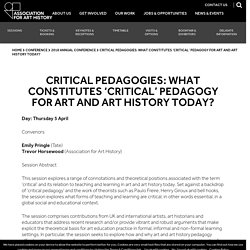
For Art History – Shaping the future for art history. Future Learning Spaces 0. Knowledge, Values and Ambiguity in the Creative Curriculum. Art and Design Pedagogy in Higher Education provides a contemporary volume that offers a scholarly perspective on tertiary level art and design education.
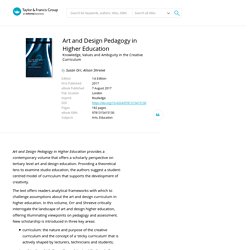
Providing a theoretical lens to examine studio education, the authors suggest a student-centred model of curriculum that supports the development of creativity. The text offers readers analytical frameworks with which to challenge assumptions about the art and design curriculum in higher education. In this volume, Orr and Shreeve critically interrogate the landscape of art and design higher education, offering illuminating viewpoints on pedagogy and assessment. New scholarship is introduced in three key areas: These insights from the perspective of a creative university subject area also offer new ways of viewing other disciplines, and provide a response to a growing educational interest in cross-curricular creativity. Drawing together.